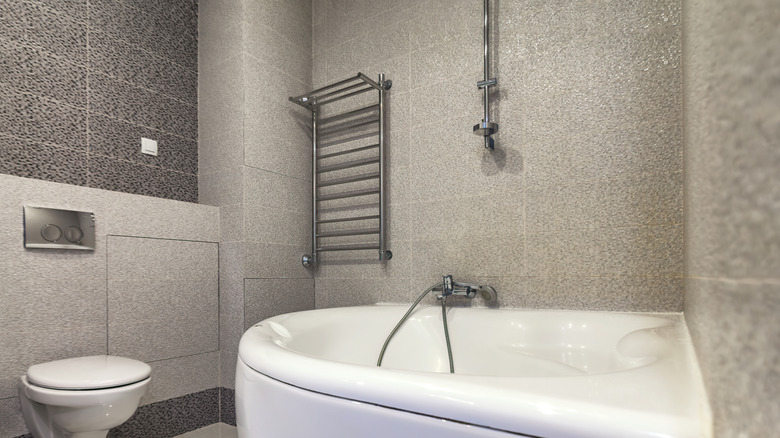Transform Your Corner Shower Space With An Easy Curtain Rod Installation
We may receive a commission on purchases made from links.
For better or worse, the former owner of your home decided they just knew a corner bathtub was right for the bathroom. Stopping water splashing everywhere when you wash has been a troublesome task at best ever since you moved in. A standard shower curtain rod is easy enough to install, sure. But things get decidedly trickier when you're dealing with a corner shower or bath. The solution is a shower curtain rod with a bend in its length so that it curves neatly around a shower or bathtub. While installation is similar to a straight shower curtain rod in that it involves wall brackets, there are a few extra parts you'll need to install, too, like additional ceiling support.
Corner shower curtain rods generally fall into three styles. The first is a rod with a 90-degree angle and matching pole lengths on either side of the curve. This 24 to 53 inch adjustable black-hued example from Anndason will set you back just over $30. Next, there's the L-shaped rods, where one side of the curve is much longer than the other; and an irregular curved rod, often with more than one corner or turn. Sikaiqi sells a silver-hued metal L-shaped rod measuring 63 x 23 inches for about $30. Finally, you can get shower curtain rods that feature two curves instead of one. They're perfect for hiding away that triangular 1980s jacuzzi bathtub or indoor hot tub (what's the difference, anyway?) installed diagonally across a corner. A reasonable investment of $60 will get you a Quany Life stainless steel corner rod — each of the three lengths 24 inches — with a ceiling support.
How to install a corner shower curtain rod in your bathroom
No matter where you bought your shower curtain rod, it almost certainly came with installation instructions. Read those, of course, but broadly speaking, most of these products are installed similarly. The fixture will come with two wall brackets or anchors for your wall — some screw in and others come with waterproof construction adhesive or caulk. You'll need to use a diamond bit to drill through tiles. If your kit comes with flange covers, install them over the anchors now. Insert the rod into the brackets, tightening the screw until the rod no longer wiggles in the hole. Not all sets feature a ceiling anchor, but if yours does, screw that into the ceiling and your rod as the last step — this way you'll ensure you get it in the correct place. Note, too, that you might need to trim either your curtain rod or the ceiling support rod down to size using a hacksaw.
Now all that's left is to hang your curtain! If you installed a rod without a ceiling support, a regular shower curtain should fit your fixture. If you have ceiling support, you'll likely need two curtains since a single curtain will get stuck on the support bar. Otherwise, a regular shower curtain will work just fine. Outside of this issue, all the usual tips for choosing the correct shower curtain size apply. Measure your rod lengthways and down to the floor before you go curtain shopping to ensure you get a curtain that will fit the space properly, and choose a quality curtain that is water resistant and washable.
